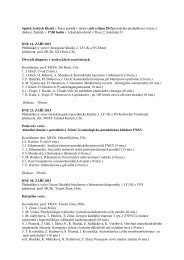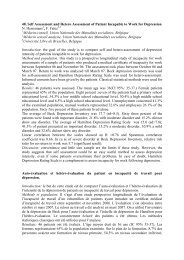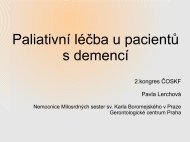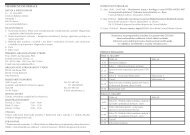ABSTRACTS â ORAL PRESENTATIONS - AMCA, spol. s r.o.
ABSTRACTS â ORAL PRESENTATIONS - AMCA, spol. s r.o.
ABSTRACTS â ORAL PRESENTATIONS - AMCA, spol. s r.o.
You also want an ePaper? Increase the reach of your titles
YUMPU automatically turns print PDFs into web optimized ePapers that Google loves.
CD133 protein was detected after using demethylating agent 5-aza-2’-deoxycytidine.<br />
Flowcytometric and western blot analysis showed that VPA treated culture increased<br />
expression of CD133 protein to several folds and maintained it high as far as VPA is<br />
included in the culture of SHSY5Y, UKF-NB3 NBL cell lines. On the other hand, Valpromid,<br />
a carboxamide derivative of VPA that lack the histone deacetylase inhibition effect<br />
doesn‘t induce CD133 expression in UKF-NB3 which confirms the regulation of CD133<br />
by the state of histone.<br />
We also highlight that hypoxia (1% oxygen) induced robust down regulation of CD133<br />
up to disappearance of the protein expression in UKF-NB3 cell line. Hypoxia-inducible<br />
factors seem to be involved in this regulation because the same effect was obtained<br />
when cobalt chloride, that mimic hypoxia by inducing hypoxia-inducible factors, was<br />
added to culture in normoxia. Moreover, the great effect of VPA on expansion of<br />
CD133 in normoxia, was diminished in hypoxic condition and is regained again when<br />
VPA is combined with 5-aza-2’-deoxycytidine, suggesting that part of the cells acquired<br />
methylation of the CD133 promoter in hypoxic condition.<br />
The regressive response of the amount of CD133 in hypoxia is unusual to CSCs behavior<br />
in comparison to CD133 positive cells in other solid tumours (Soeda et al., 2009) that<br />
is of great importance to understand the tumor microenvironment and the different<br />
reaction of CD133 expression in various cell types in response to hypoxia. Obviously,<br />
CD133 gene expression is directly controlled by epigenetic regulation.<br />
Acknowledgments<br />
This work was supported by GAUK grant No 620612 and GAČR No No P301/10/0356.<br />
Refrences<br />
Qianga L, Yanga Y, Ma YJ, et al.,: Isolation and characterization of cancer stem like cells in<br />
human glioblastoma cell lines. Cancer Letters 279: 13–21 (2009).<br />
Soeda A, Park M, Lee D, et al.: Hypoxia promotes expansion of the CD133-positive glioma<br />
stem cells through activation of HIF-1a. Oncogene 28: 3949–3959 (2009).<br />
Tabu K, Sasai K, Kimura T, et al.: Promoter hypomethylation regulates CD133 expression<br />
in human gliomas. Cell Research 18:1037-1046 (2008).<br />
Tong QS, Zheng LD, Tang ST, et al.: Expression and clinical significance of stem cell marker<br />
CD133 in human neuroblastoma. World J Pediatr 4(1):58-62 (2008)<br />
61. POPULATION DYNAMICS OF SP-PHENOTYPE UNDER IN VITRO CONDITIONS<br />
Jaromír Mikeš, Jana Vargová, Lucia Mikešová, Zuzana Zsihovicsová, Ján Kovaľ, Rastislav<br />
Jendželovský, Peter Fedoročko<br />
Institute of Biology and Ecology, University of Pavol Jozef Šafárik in Košice, Slovak Republic;<br />
jaromirmikes@yahoo.com<br />
A concept of cancer cells with “mighty” powers of stem cells was primarily identified and<br />
issued in haematological malignancies in 1990’s and it seems to be valid in solid tumour,<br />
too. The main consequence accrued from this concept is the existence of rare cells,<br />
aka “cancer stem-like cells” (cSCs), with a high resistance to anti-cancer therapy and<br />
Analytical Cytometry VII 77








